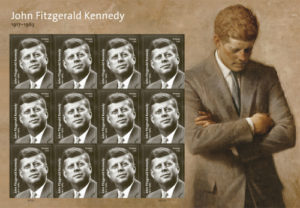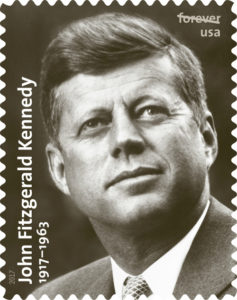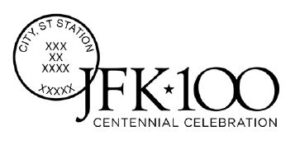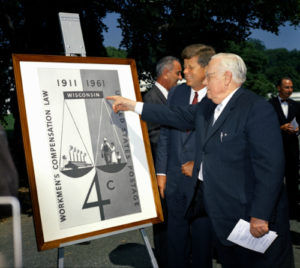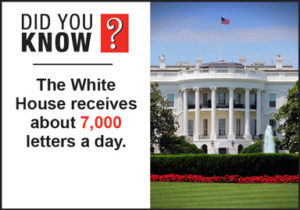USPS Introduces John F. Kennedy Stamp in Honor of President’s Day
A president for President’s Day — that’s what the Postal Service™ planned this year when introducing a new 2017 Forever® stamp which recognizes the centennial of the birth of John Fitzgerald Kennedy at a ceremony in February.
Kennedy was the 35th president of the United States, the nation’s first Catholic president and at age 43, the youngest person elected to the nation’s highest office.
The president was assassinated on Nov. 22, 1963 and though I never had a chance to meet him, through research at the John F. Kennedy Presidential Library and Museum in Boston, MA, and the modern conveniences of a phone and computer, I’ve become acquainted with him in more ways than just face to face.
JFK Stamps
Three U.S. stamps feature John Fitzgerald Kennedy; the 5-cent stamp released on Kennedy’s birthday May 29, 1964 and the 13-cent stamp released on what would have been his 50th birthday in 1967. He also appeared on the two-page Ameripex stamp issue of “Presidents of the United States” in 1986.
The fourth John F. Kennedy stamp has debuted, featuring a photograph by Ted Spiegel of Kennedy campaigning for president in Seattle, WA, in 1960. The art on the stamp sheet, designed by art director Derry Noyes, shows President Kennedy in reflective pose in a 1970 oil painting by Aaron Shikler (courtesy of the White House/White House Historical Association).
With this stamp, Kennedy stands in the halls of philatelic history with Presidents George Washington and Abraham Lincoln, having been honored with three or more individual stamps. All deceased presidents before 1986 are depicted in the 1986 “Presidents of the United States” issue and some have their own stamps too. An earlier presidential grouping in 1938 portrayed all presidents from 1789 to 1928.
Though JFK was not a stamp collector, the public still sent him stamps on subjects such as St. Patrick’s Day, the 50th Anniversary of the Chinese Revolution and General John J. Pershing. One stamped envelope had a picture of the San Francisco-Oakland Bay Bridge. He and Mrs. Kennedy were asked to sign it after it had been signed by Presidents Hoover, Eisenhower, and Roosevelt and their wives.
As Kennedy’s fame grew worldwide, his philatelic sensation also spread and is more easily seen today on the internet. One website claims over 400 postage stamps from numerous countries with JFK and related subjects.
KN-C18708, 31 August 1961
President John F. Kennedy and Senator Alexander Wiley of Wisconsin look at an image of the commemorative stamp created to mark the fiftieth anniversary of the first state Workmen’s Compensation Law, enacted in Wisconsin in 1911.
Photo credit: Robert Knudsen. White House Photographs. John F. Kennedy Presidential Library and Museum, Boston.
Commemorative Stamps Celebrate Notable People and Achievements
Stamps are one way to indicate fame. Again, the internet comes to the rescue publicizing every John F. Kennedy street, park, airport, and school in the world. John F. Kennedy Presidential Library Reference Archivist Stacey Chandler said, “The research room doesn’t keep a complete list of the institutions named after John F. Kennedy. I know that at one point very early in the library’s history, attempts were made to try to keep up with this; however, the number of schools, streets, and other sites named after him grew more quickly than staff could track them, so we don’t have a current list of them now.”
Two well-known namesake postal buildings are John Fitzgerald Kennedy Station in Boston and JFK International Service Center in Jamaica, NY. Parkhill Post Office in North Little Rock, AR is also on John F. Kennedy Boulevard and the Papillion Branch of Omaha, NE, was dedicated to the president.
There’s more to the physical, intellectual and political legacy that Kennedy left behind — that’s the people — his family, the nation and colleagues. In a recent interview, Thomas Costin, now 90, talked about his relationship to Kennedy whom he first met in 1946 when he shook his hand after a rally. As a member of the Lynn, MA, City Council at age 21, Costin had made an impression on Kennedy’s father Joe, who told John and his brother Ted to work with him on legislation involving cities.
After many interactions, Kennedy offered Costin a job in Washington DC which he turned down to stay local. But at Kennedy’s inauguration, Kennedy asked Costin about a position. He said he wanted to be Postmaster in Lynn and Kennedy said yes. During those times people worked through their local political leaders to get positions. “It was very political,” Costin said. “My name was the only one that the President himself sponsored that year before the Senate took a vote on it.”
Postmaster jobs are no longer political appointments and the Postmaster General is no longer part of the president’s cabinet.
Costin says of his time as a Postmaster from 1961 to 1992: “If we hadn’t modernized, we would be out of business today.”
Postal Improvements
One of the biggest postal legacies during Kennedy’s administration was the introduction of the Zone Improvement Plan (ZIP Codes) on July 1, 1963. With ZIP Codes, the mail came closer to being on the road to automation.
Other key postal events during Kennedy’s lifetime include:
1918: Scheduled airmail service began
1920: Metered postage authorized
1923: Mail slots or receptacles were required for delivery service
1943: Postal zoning system (the precursor to the ZIP Code) began in 124 large cities (Kennedy was 26 years old)
1950: Residential deliveries reduced to once a day
1955: Certified mail introduced
1957: Citizens’ Stamp Advisory Committee created (selects subjects for recommendation as future stamp issues, made with all postal customers in mind, including stamp collectors).
1959: Missile mail dispatched from submarine to mainland Florida
1963: ZIP Code plan launched
